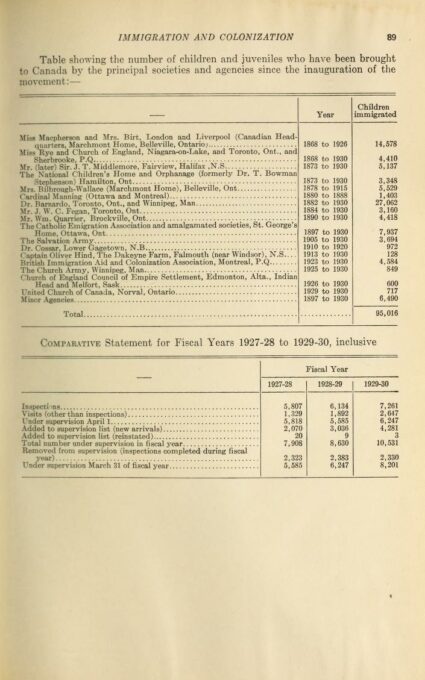Last Friday, I blogged, “I’m doubtful there were as many as 100,000 home children, as properly defined, who arrived in Canada between 1869 and the start of WW2.”
I’ve now come across the following from the 1930 Annual Report of the Department of Immigration and Colonization.

The total to 1930 of 95,016 emigrated by the various agencies is more than I anticipated. Add to it 1,018 names included in the LAC database to 1939 and the total is 96,034. Not quite 100,000, but close.
Those are the official figures. They must be the truth is they come from the government!
Are they actualy children as described by the column heading?
A sample passenger list for 1900 showed 2.2 percent were age 19 of older. If applicable to the whole it reduces the total to an estimated 93,900.
In Britain the Elementary Education Act (1870) required that children aged between five and 13 should be able to attend a school. In 1880 a further Education Act made school attendance compulsory between the ages of five and ten.
Older than 13 and they would be expected to enter the workforce, as did both my parents in the late 1920s.
It’s debateable whether those past the school leaving age were properly classed as children. About 20% of that 1900 group were beyond school leaving age. The terminology used for those older was often juveniles or young people.


These articles are really interesting. Thank you. I have a cousin who’s great grandmother Georgina May Wright born Wren 1905 – 1965.
We have started work on it but she lost her mother in 1910 and was shipped out to Canada with her sister Henrietta on the Tunisian arriving on 15 May 1910. According to 1911 census she was adopted and shown as Georgina Turnbull at 110 Perth North Stratford. We have not found her on 1921 as of yet but she returned to England as Georgina Wren on Victorian on 22nSeptember 1922.
Early days on the research but not sure who sent her out under the title British Home Children and therefore appears in as part of the statistics you have published.
Always nice to know more to get a social perspective.
Nick
Nick McDonald
Croydon UK
I am following this ongoing story with great interest. That 1930 Annual report is fascinating. Keep on researching, John. Much appreciated.
My father-in-law and his younger brother were brought out together by Middlemore Homes on the Carthaginian sailing from Liverpool to Halifax in May 1906. They were assigned to separate families in the Baddeck area of Victoria County, Nova Scota. The younger brother joined the C.E.F. and remaine in England, while my father-in-law remained in Nova Scotia. He did enlist, but his host family got him out of the army saying he was needed on the farm! We got copies of the recrods of both from LAC.
How fascinating! I had no idea individuals were also involved in bringing Home Children over to Canada.
I was recently doing some research on Home Children and noted that in the passenger lists those 13 and over are described as “labourers” and those under as “children” .
By our current standards both would be children…
Different times, different definitions